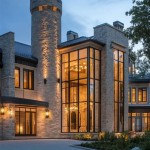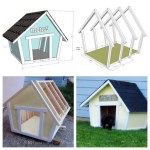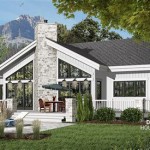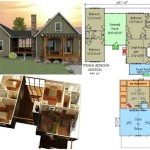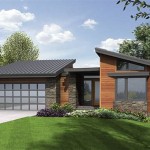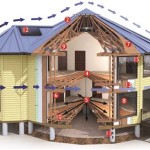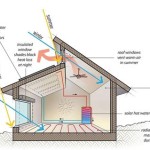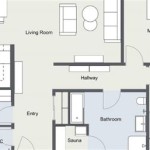Eichler Style House Plans refer to a particular design aesthetic for residential architecture that emerged in the mid-20th century. Created by developer Joseph Eichler and his team of architects, these plans emphasized open floor plans, large windows, and a strong connection between indoor and outdoor spaces. Eichler homes became synonymous with the California Modern style and were often marketed towards middle-class families seeking a modern and stylish living environment.
The distinctive features of Eichler Style House Plans include post-and-beam construction, which allowed for expansive glass walls that blurred the boundaries between the interior and exterior. The homes typically featured open floor plans with minimal walls and partitions, creating a spacious and airy living environment. Large windows and sliding glass doors provided ample natural light and facilitated indoor-outdoor living, a key characteristic of California Modernism.
In the following sections, we will delve deeper into the history, architectural details, and enduring appeal of Eichler Style House Plans. We will explore the unique design elements that define these homes and the reasons why they continue to be popular choices for homeowners seeking a modern and stylish living experience.
Eichler Style House Plans are notable for their distinctive design features, which include:
- Post-and-beam construction
- Expansive glass walls
- Open floor plans
- Indoor-outdoor living
- Atriums
- Courtyards
- Sloped roofs
- Recessed entries
- Carports
- Natural materials
These design elements combine to create a unique and stylish living environment that is both modern and timeless.
Post-and-beam construction
Post-and-beam construction is a building method that uses vertical posts and horizontal beams to create a structural framework. This type of construction was popularized in the mid-20th century by architects such as Frank Lloyd Wright and Joseph Eichler.
Post-and-beam construction has several advantages over traditional stick framing. First, it is more flexible and can be used to create a wider variety of floor plans. Second, it is more resistant to earthquakes and other natural disasters. Third, it allows for larger windows and doors, which can create a more open and airy living space.
In Eichler Style House Plans, post-and-beam construction is used to create a distinctive look and feel. The exposed beams and posts add a sense of warmth and character to the home. The large windows and doors allow for plenty of natural light and ventilation, creating a bright and inviting living space.
- Strength and durability: Post-and-beam construction creates a strong and durable structure that is resistant to earthquakes, high winds, and other natural disasters.
- Flexibility: Post-and-beam construction allows for more flexibility in floor plans and room layouts than traditional stick framing. This flexibility allows architects to create unique and innovative designs.
- Energy efficiency: The large windows and doors in Eichler Style House Plans allow for plenty of natural light and ventilation, which can reduce energy costs.
- Aesthetic appeal: The exposed beams and posts add a sense of warmth and character to Eichler Style House Plans. The large windows and doors create a bright and inviting living space.
Post-and-beam construction is a key element of Eichler Style House Plans. It is a versatile and durable building method that can be used to create a variety of unique and stylish homes.
Expansive glass walls
Expansive glass walls are a defining feature of Eichler Style House Plans. These walls allow for a seamless connection between the indoor and outdoor spaces, creating a bright and airy living environment. The large windows and doors also provide ample natural light and ventilation, which can reduce energy costs.
The use of expansive glass walls in Eichler homes was inspired by the California Modernist movement, which emphasized the connection between indoor and outdoor living. This design philosophy was particularly well-suited to the California climate, which is characterized by mild temperatures and ample sunshine.
In addition to their aesthetic appeal, expansive glass walls also offer several practical benefits. They allow for natural light to penetrate deep into the home, reducing the need for artificial lighting. They also provide passive solar heating, which can help to reduce energy costs in the winter. And, they offer stunning views of the surrounding landscape, creating a more enjoyable living environment.
There are a few things to consider when designing a home with expansive glass walls. First, it is important to choose the right type of glass. There are a variety of different glass options available, each with its own unique benefits and drawbacks. It is important to choose a glass that is energy-efficient and provides adequate protection from the sun’s harmful UV rays.
Second, it is important to consider the placement of the glass walls. The placement of the windows and doors will determine how much natural light and ventilation the home receives. It is important to place the windows and doors in a way that maximizes natural light and ventilation while also providing privacy and security.
Finally, it is important to consider the cost of installing and maintaining expansive glass walls. Glass walls can be more expensive to install and maintain than traditional windows and doors. However, the benefits of expansive glass walls often outweigh the costs.
Expansive glass walls are a key element of Eichler Style House Plans. They create a bright and airy living environment, provide ample natural light and ventilation, and offer stunning views of the surrounding landscape. When designing a home with expansive glass walls, it is important to choose the right type of glass, consider the placement of the windows and doors, and factor in the cost of installation and maintenance.
Open floor plans
Open floor plans are a defining feature of Eichler Style House Plans. These plans typically feature a large, open living space that combines the living room, dining room, and kitchen into one cohesive space. This type of floor plan creates a sense of spaciousness and openness, and it allows for a more fluid and flexible use of space.
There are many advantages to open floor plans. First, they allow for more natural light to penetrate deep into the home. This can create a brighter and more inviting living environment. Second, open floor plans promote a more social atmosphere. Family members and guests can easily interact with each other, even if they are in different parts of the house.
Third, open floor plans are more flexible and adaptable than traditional floor plans. They can be easily reconfigured to accommodate changing needs. For example, a family with young children might choose to use the open space as a play area. As the children get older, the space can be reconfigured to accommodate a more formal living room or dining room.
Of course, there are also some potential drawbacks to open floor plans. One potential drawback is that they can be more difficult to heat and cool than traditional floor plans. This is because there are fewer walls to separate the different zones of the house. Another potential drawback is that open floor plans can be more noisy than traditional floor plans. This is because there are fewer walls to absorb sound.
Overall, open floor plans offer a number of advantages over traditional floor plans. They create a more spacious and open living environment, they promote a more social atmosphere, and they are more flexible and adaptable. However, it is important to weigh the potential drawbacks of open floor plans before making a decision about whether or not this type of floor plan is right for you.
Open floor plans are a key element of Eichler Style House Plans. They create a spacious and open living environment, promote a more social atmosphere, and are more flexible and adaptable than traditional floor plans. When considering an open floor plan, it is important to weigh the potential benefits and drawbacks to determine if this type of floor plan is right for you.
Indoor-outdoor living
Indoor-outdoor living is a key element of Eichler Style House Plans. This design philosophy emphasizes the connection between the interior and exterior spaces of the home, creating a seamless flow between the two. This is achieved through the use of large windows and doors, open floor plans, and outdoor living areas.
There are many advantages to indoor-outdoor living. First, it allows for a more natural and healthy lifestyle. Spending time outdoors has been shown to have a number of benefits, including reducing stress, improving mood, and boosting creativity. Indoor-outdoor living allows people to enjoy the benefits of being outdoors without having to leave the comfort of their home.
Second, indoor-outdoor living can help to create a more spacious and open living environment. By opening up the home to the outdoors, the interior space feels larger and more connected to the surrounding landscape. This can be especially beneficial in smaller homes or in homes that are located on small lots.
Third, indoor-outdoor living can help to reduce energy costs. By allowing natural light and ventilation to penetrate deep into the home, indoor-outdoor living can reduce the need for artificial lighting and air conditioning.
Indoor-outdoor living is a key element of Eichler Style House Plans. It creates a more natural and healthy lifestyle, a more spacious and open living environment, and can help to reduce energy costs. When designing a home with indoor-outdoor living in mind, it is important to consider the following factors:
- Climate: The climate in which you live will determine the type of indoor-outdoor living spaces that you can create. In warm climates, you may be able to create a year-round outdoor living space. In colder climates, you may need to create a more seasonal outdoor living space.
- Lot size and orientation: The size and orientation of your lot will also determine the type of indoor-outdoor living spaces that you can create. A larger lot will give you more options for creating outdoor living spaces. A lot that is oriented towards the south will receive more sunlight, which can be beneficial for creating a warm and inviting outdoor living space.
- Privacy: It is important to consider privacy when designing your indoor-outdoor living spaces. You want to create spaces that are open and inviting, but you also want to ensure that you have privacy from your neighbors.
With careful planning, you can create indoor-outdoor living spaces that are both beautiful and functional. These spaces will allow you to enjoy the benefits of being outdoors without having to leave the comfort of your home.
Atriums
Atriums are a common feature in Eichler Style House Plans. An atrium is a central courtyard that is surrounded by the home’s living spaces. Atriums bring natural light and ventilation into the home, and they can also be used to create a private outdoor living space.
- Natural light and ventilation: Atriums are a great way to bring natural light and ventilation into the home. The large windows and doors that surround the atrium allow sunlight to penetrate deep into the home, even on overcast days. The atrium also helps to circulate air, which can help to keep the home cool in the summer and warm in the winter.
- Private outdoor living space: Atriums can also be used to create a private outdoor living space. The atrium is typically enclosed by walls or fences, which creates a sense of privacy and seclusion. This makes the atrium a great place to relax and enjoy the outdoors without having to worry about being disturbed by neighbors or passersby.
- Architectural interest: Atriums can also add architectural interest to a home. The large windows and doors that surround the atrium create a dramatic visual effect, and the atrium can also be used to display plants and other decorative items.
- Passive solar heating: In colder climates, atriums can be used to provide passive solar heating. The large windows and doors that surround the atrium allow sunlight to enter the home, which can help to warm the home in the winter. The atrium can also be used to store heat, which can be released into the home at night.
Atriums are a versatile and stylish addition to any home. They can be used to provide natural light and ventilation, create a private outdoor living space, add architectural interest, and provide passive solar heating. If you are considering adding an atrium to your home, be sure to consult with an architect to discuss the best way to design and build an atrium that meets your needs.
Courtyards
Courtyards are another common feature in Eichler Style House Plans. A courtyard is a small, enclosed outdoor space that is surrounded by the home’s living spaces. Courtyards provide a private and secluded outdoor living space, and they can also be used to bring natural light and ventilation into the home.
- Private and secluded outdoor living space: Courtyards are a great way to create a private and secluded outdoor living space. The walls or fences that surround the courtyard create a sense of privacy and seclusion, making the courtyard a great place to relax and enjoy the outdoors without having to worry about being disturbed by neighbors or passersby.
- Natural light and ventilation: Courtyards can also be used to bring natural light and ventilation into the home. The large windows and doors that surround the courtyard allow sunlight to penetrate deep into the home, even on overcast days. The courtyard also helps to circulate air, which can help to keep the home cool in the summer and warm in the winter.
- Architectural interest: Courtyards can also add architectural interest to a home. The large windows and doors that surround the courtyard create a dramatic visual effect, and the courtyard can also be used to display plants and other decorative items.
- Passive solar heating: In colder climates, courtyards can be used to provide passive solar heating. The large windows and doors that surround the courtyard allow sunlight to enter the home, which can help to warm the home in the winter. The courtyard can also be used to store heat, which can be released into the home at night.
Courtyards are a versatile and stylish addition to any home. They can be used to create a private and secluded outdoor living space, bring natural light and ventilation into the home, add architectural interest, and provide passive solar heating. If you are considering adding a courtyard to your home, be sure to consult with an architect to discuss the best way to design and build a courtyard that meets your needs.
Courtyards are a key element of Eichler Style House Plans. They provide a private and secluded outdoor living space, bring natural light and ventilation into the home, add architectural interest, and can be used for passive solar heating. When designing a courtyard, it is important to consider the following factors:
- Climate: The climate in which you live will determine the type of courtyard that you can create. In warm climates, you may be able to create a year-round outdoor living space. In colder climates, you may need to create a more seasonal outdoor living space.
- Lot size and orientation: The size and orientation of your lot will also determine the type of courtyard that you can create. A larger lot will give you more options for creating a courtyard. A lot that is oriented towards the south will receive more sunlight, which can be beneficial for creating a warm and inviting outdoor living space.
- Privacy: It is important to consider privacy when designing your courtyard. You want to create a space that is private and secluded, but you also want to ensure that you have adequate natural light and ventilation.
- Functionality: Consider how you will use your courtyard. Will you use it for dining, entertaining, or simply relaxing? Once you know how you will use your courtyard, you can design it to meet your specific needs.
With careful planning, you can create a courtyard that is both beautiful and functional. Your courtyard will be a private and secluded outdoor living space that you can enjoy for years to come.
Sloped roofs
Sloped roofs are a common feature in Eichler Style House Plans. These roofs are typically low-pitched and have a wide overhang, which helps to protect the home from the sun and rain. Sloped roofs also add a sense of drama and architectural interest to the home.
There are many advantages to sloped roofs. First, they are more durable than flat roofs. A sloped roof allows water to drain off quickly, which prevents the roof from leaking. Second, sloped roofs are more energy-efficient than flat roofs. The air space between the roof and the ceiling helps to insulate the home, which can reduce energy costs. Third, sloped roofs are more aesthetically pleasing than flat roofs. The varied angles and slopes of a sloped roof can create a more visually interesting home.
Of course, there are also some potential drawbacks to sloped roofs. First, they can be more expensive to build than flat roofs. Second, sloped roofs can be more difficult to maintain than flat roofs. The steep slopes can make it difficult to clean the roof and repair any damage.
Overall, sloped roofs offer a number of advantages over flat roofs. They are more durable, more energy-efficient, and more aesthetically pleasing. However, it is important to weigh the potential drawbacks of sloped roofs before making a decision about whether or not this type of roof is right for you.
Sloped roofs are a key element of Eichler Style House Plans. They add a sense of drama and architectural interest to the home, and they offer a number of advantages over flat roofs. When considering a sloped roof for your home, it is important to weigh the potential benefits and drawbacks to determine if this type of roof is right for you.
Recessed entries
Recessed entries are a common feature in Eichler Style House Plans. A recessed entry is a doorway that is set back from the front of the house. This creates a covered porch area that can be used for a variety of purposes, such as relaxing, entertaining, or simply storing shoes and coats. Recessed entries also add a sense of depth and architectural interest to the home.
There are many advantages to recessed entries. First, they provide a sheltered area where you can enter and exit the home without getting wet or cold. This is especially beneficial in climates with extreme weather conditions. Second, recessed entries can help to improve the home’s energy efficiency. The covered porch area acts as a buffer between the inside and outside of the home, which can help to reduce heat loss in the winter and heat gain in the summer. Third, recessed entries can add curb appeal to the home. A well-designed recessed entry can make the home look more inviting and stylish.
Of course, there are also some potential drawbacks to recessed entries. First, they can be more expensive to build than traditional entries. Second, recessed entries can make the home less accessible for people with disabilities. Third, recessed entries can be difficult to maintain, especially if they are located in an area that is exposed to the elements.
Overall, recessed entries offer a number of advantages over traditional entries. They provide a sheltered area for entering and exiting the home, can help to improve the home’s energy efficiency, and can add curb appeal. However, it is important to weigh the potential drawbacks of recessed entries before making a decision about whether or not this type of entry is right for you.
Recessed entries are a key element of Eichler Style House Plans. They add a sense of depth and architectural interest to the home, and they offer a number of advantages over traditional entries. When considering a recessed entry for your home, it is important to weigh the potential benefits and drawbacks to determine if this type of entry is right for you.
Carports
Carports are a common feature in Eichler Style House Plans. A carport is a covered parking area that is attached to the home. Carports provide protection for your car from the sun, rain, and snow. They can also be used for other purposes, such as storage or entertaining.
There are many advantages to having a carport. First, carports can help to protect your car from the elements. The covered roof will shield your car from the sun’s harmful UV rays, which can damage the paint and interior of your car. Carports can also protect your car from rain, snow, and hail. This can help to prevent rust and other damage to your car.
Second, carports can provide additional storage space. You can use the carport to store items that you don’t use on a regular basis, such as seasonal decorations, sporting equipment, or gardening tools. Carports can also be used to store firewood or other bulky items.
Third, carports can be used for entertaining. You can use the carport to host parties or gatherings. You can also use the carport to create a shaded area for outdoor activities, such as grilling or playing games.
There are a few things to consider when designing a carport. First, you need to decide on the size of the carport. The size of the carport will depend on the number of cars that you need to park. You should also consider the size of your car and the amount of space that you need to maneuver your car in and out of the carport.
Second, you need to decide on the type of carport that you want. There are two main types of carports: attached carports and detached carports. Attached carports are attached to the home, while detached carports are freestanding. Attached carports are typically more expensive than detached carports, but they offer more protection from the elements.
Natural materials
Natural materials are a key element of Eichler Style House Plans. Eichler homes were designed to be in harmony with nature, and the use of natural materials helps to create a warm and inviting living environment.
The most common natural materials used in Eichler homes are wood, stone, and glass. Wood is used for framing, siding, and flooring. Stone is used for fireplaces, patios, and walkways. Glass is used for windows, doors, and skylights.
Other natural materials that may be used in Eichler homes include brick, tile, and metal. Brick is often used for chimneys and exterior walls. Tile is often used for bathrooms and kitchens. Metal is often used for roofing and gutters.
The use of natural materials in Eichler homes helps to create a sense of warmth and connection to nature. Natural materials are also durable and easy to maintain, making them a good choice for a home that is built to last.
There are many benefits to using natural materials in your home. Natural materials are sustainable and environmentally friendly. They are also durable and easy to maintain. And, natural materials can help to create a warm and inviting living environment.
If you are considering building or remodeling a home, consider using natural materials. Natural materials can help you to create a home that is both beautiful and sustainable.










Related Posts

